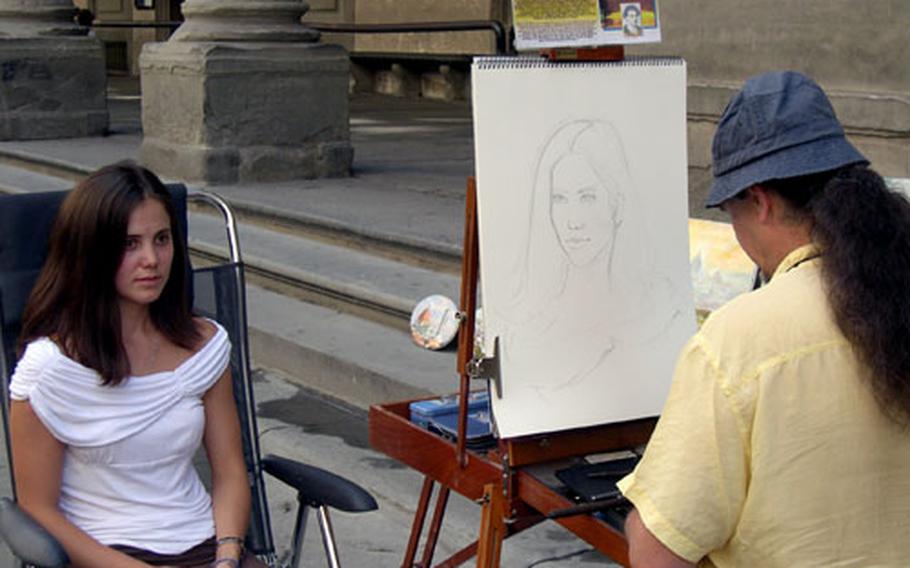
Marco Ramazzotti gets the portrait started with a quick outline; gradually he fills in the work to its detailed, finished beauty. (Mary Kieran / Special to S&S)
Florence is credited with being the birthplace of the Renaissance and the center for art and culture in Italy. Some 500 years later, the city is still known for its artists, producing objects that are both fine art and souvenirs.
Many of these modern-day artists gather in the courtyard outside the Uffizi Gallery, offering on-the-spot portraits and cartoon sketches, along with Tuscan landscapes and other original works.
These artists have a lot in common with their predecessors because they, too, struggle to make a living in Florence as an artist. But are they, like those greats, also capable of producing art that can make your heart sing? Walk through the Uffizi courtyard, look at the art and decide for yourself.
When traveling, I enjoy seeing what kind of work artists on the street are doing. In Rome, the Piazza Navona has its collection of street artists, and Paris has artists offering to do portraits near the Eiffel Tower and other locations.
But when I stop for a closer look, I am not aware of any singing in my heart.
Most artists I have seen are doing caricatures or cartoon sketches rather than serious portraits. Although it is somewhat amusing to see Barbra Streisand or Roberto Benigni with a nose like the prow of a ship, who wants to be made fun of in a portrait that will be seen by friends and family? Where, I wonder, are the artists doing traditional portraits that will become heirlooms?
Then I spotted Marco Ramazzotti sitting in the Uffizi courtyard between the statues of Leonardo de Vinci and Dante.
He was working on a portrait of a young woman, and the first thing I noticed was that he was not doing an exaggerated cartoon of his model. Then I noticed what a fine job he was doing of capturing the likeness of his subject.
Michelangelo said that he simply released the subject that was trapped inside the marble when he was sculpting. I could see that Marco knew how to release the natural beauty of a person and capture it in his work.
In less than an hour, and for less than $100, Marco had finished a lovely, detailed, charcoal drawing that could be treasured for generations. An heirloom, some might say.
What kind of person chooses to be an artist in today’s fast-paced 21st century? And can an artist really support a family painting for a living?
Marco was born in Sardinia, where he says he grew up and learned to appreciate the beauty in nature and the wilderness of the countryside. By age 5, while friends were playing soccer, Marco spent hours drawing just to please himself.
Marco’s family moved to Florence, where he attended a high school for art, and later studied architecture. After working for a while in architectural and graphic design, he decided to make a change.
“I came back to my first love — painting,” he says.
And that is why he can now be found most days in the Uffizi courtyard working on art projects. He works in charcoal, watercolor, oil, pastel and airbrush doing portrait, landscape and trompe l’oeil works.
Marco lives with his wife Ulrike, and their 3-year-old son, Oliver, in an apartment across the Arno River near Piazzale Michelangelo. His art studio is just a few blocks away, so he can strap art supplies on his well- worn bicycle to travel between his home, his studio and the Uffizi.
When asked which artists have inspired him, Marco says he admires Leonardo da Vinci for the universality of his art. He also appreciates other architectural artists, such as Filippo Brunelleschi and Lorenzo Ghiberti, who brought innovation and progress to traditional art forms.
But while he draws inspiration from the old masters, when he is painting he prefers to listen to Pink Floyd.
His daily routine is simple. “I take a coffee and take my bike and go to the Uffizi,” he says. “There I usually paint watercolors, because it helps me to feel good.”
If you want to feel good, too, next time you are in Florence, go to the Uffizi courtyard and look up Marco Ramazzotti. Have him do a portrait of you or someone you care about.
Or, just watch him while he works. To see a few swiftly sketched lines take shape and transform themselves into a striking likeness of the subject is to witness living and breathing art at its best. And … you just may notice something fluttering in your own heart.
Mary Kieran is a freelance writer living in Italy. Write her at wordsforsale@hotmail.com.
Know and Go
Marco Ramazzotti can be reached by telephone at (+39) 055 2344 875, by cell at (+39) 348-883- 4201, or by e-mail at info@ramazzottiart.it. His Web site is www.ramazzottiart.it.
He works in charcoal, pastel, watercolor and airbrush, from either a photograph or a live model. Prices range from 75 euros for a charcoal portrait to 500 euros for a large oil painting.
— Mary Kieran